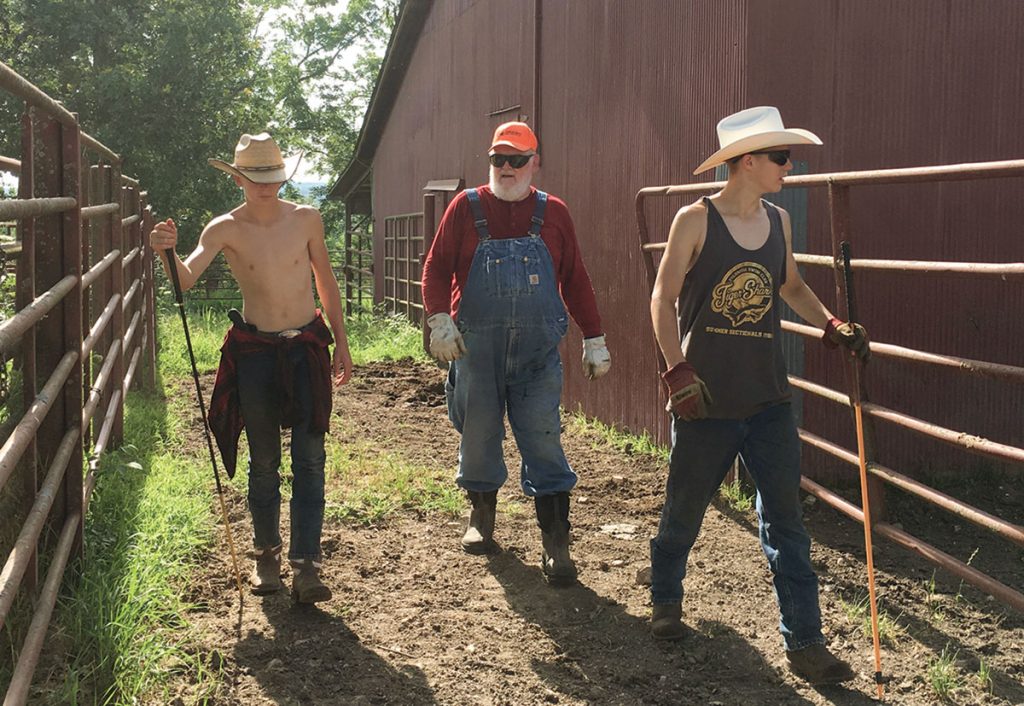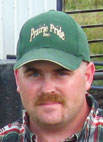
Ken Ragsdell, pictured at center with his grandsons Ben and Micah, strives for quality Limousin cattle at his Ragsdell Family Rockin’ R Ranch, LLC in Phelps County, Mo.
Ken Ragsdell credits his youngest son, Matthew with getting him and his wife, Jan into the Limousin cattle business.
“When they were in high school in Columbia, Mo., our two oldest sons, Keith and Tom, were competitive swimmers but Matthew, our youngest, had friends in 4-H,” Ken said. “They were showing steers and he wanted to join them. We had a small farm and I liked the look of the Limousin, known as the ‘Butcher’s Breed.’ The next thing we knew, Matt took second place that year at the Boone County Fair. We kept his bull and we were in the Limousin cattle business.”
A few decades have gone by since then and today Ken and Jan live in Phelps County, outside Rolla, where they keep about 35 Limousins. They also have 10 to 15 cows in Oklahoma, working in partnership with Robert Stone of Stone Valley Limousins.
“We used to have over 100 cows, bulls and heifers here but we’ve just recently downsized,” Ken said. “This is a very different business than it was in 1984 and 1985 when we began.”
The Ramsdells’ original interest in raising quality beef started with putting safe, healthy food on the table for their own family when they still had three sons at home. Today, that family also includes an even dozen grandchildren now living in Columbia and Jefferson City. The expansion of their cattle business over the years also led to the exploration of the latest technologies in agriculture available to the small rancher and how they could best be combined with basic Ozarks farming practices.
“Over the years, I’ve learned to study the EPDs carefully, using the directory available through the North American Limousin Foundation (NALF), which tracks so many different characteristics, making it so much easier to tell the probabilities that those characteristics will be passed on to the next generation,” Ken said. “We’re talking about everything from carcass traits to milk production, to fat content in the meat to weaning weights and so much more. Genetics are fascinating to me and the EPDs are great forecasting tools.
“We’ve also used an aggressive embryo transfer program as well as AI and it’s made a real difference in our production. We had an exceptional donor cow, Amber Pearl, that lived to be 17 years old. She was an extremely fertile animal and three-fourths of our cows are her daughters. She left a tremendous legacy and we still have some of her frozen embryos on hand. She’s buried on our property here.”
And over the years, Ken has found ways to combine the new techniques with the old, tried and true.
“Since we began, we’ve worked hard on temperament and now we have calm, gentle cattle,” Ken said. “I think a big part of that is certainly the genetics. The NALF now even has an EPD for temperament, but I also think it has to do with the handling of the cattle by the livestock owner. I still prefer to feed my cows by hand each day.”
Ken likes to keep a close eye on his herd, which he says helps him know each individual animal.
“Our house sits in the middle of our acreage,” the rancher who is approaching his 80th birthday explained. “We have 26 pastures and paddocks we use in our rotational grazing program that are situated on all sides of the house.
“Every morning when I get up, the first thing is I get to see everybody and check on them as I feed. That’s really helpful and let’s me see exactly what’s going on. We raise our own replacement heifers and I think watching the genetics, as well as the daily hand feeding, makes for much gentler cows. I think that is a lot of what keeps me going, too.”
A part of the health protocol of the ranch includes limiting vistors to the farm.
“We have never allowed just casual visitors on our farm,” Ken explained. “It was originally to protect against any kind of disease contamination, like something being carried in on manure on someone’s boots. But I think it really helps us to keep a more manageable herd in so many ways because they are just used to us and the one hired hand we have.”
When they started, the Ragsdell Family Rockin’ R Ranch was raising both red and black Limousins but after a few years, Ken switched over to raising only fullblood and registered red Limousins. At the beginning of 2020, he has expanded back into including some black cows in his operation.
“That is what the customers are asking for and in this business, like any other, you have to listen to your customers,” Ken explained. “We have always done AI with our cows and that, of course, often involves an Angus line, but there were still considered registered purebred as long as the bull was 93 percent Limousin and the cow was shown to be seven-eighths Limousin, crossed only with Angus. Now it is the seven-eighths threshold for both bulls and cows. If the cross was with another breed, like Hereford, then it was simply a commercial animal. In addition, there is the fullblood category which is an animal that has never had anything but registered Limousin in its background.”
The family may have stumbled into Limousin production, but they have built a solid herd and reputation in the cattle industry, and continue to look toward the future.
“We have really enjoyed raising Limousins here at the Rockin’ R Ranch for the last many years,” Ken said. “There is always something new to learn in this business.”







